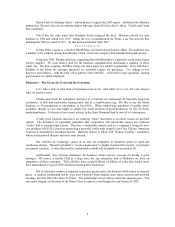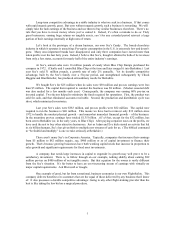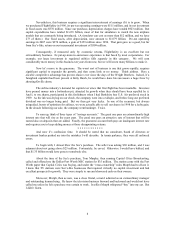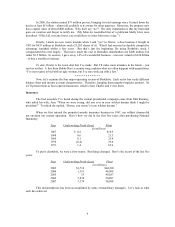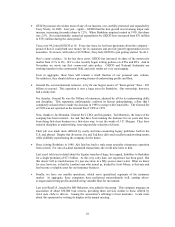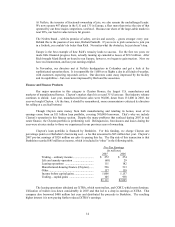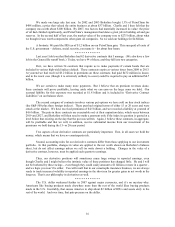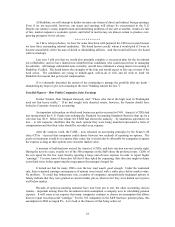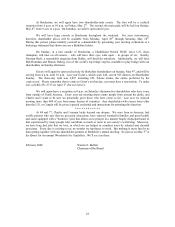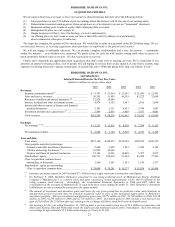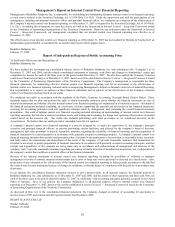Berkshire Hathaway 2007 Annual Report Download - page 17
Download and view the complete annual report
Please find page 17 of the 2007 Berkshire Hathaway annual report below. You can navigate through the pages in the report by either clicking on the pages listed below, or by using the keyword search tool below to find specific information within the annual report. We made one large sale last year. In 2002 and 2003 Berkshire bought 1.3% of PetroChina for
$488 million, a price that valued the entire business at about $37 billion. Charlie and I then felt that the
company was worth about $100 billion. By 2007, two factors had materially increased its value: the price
of oil had climbed significantly, and PetroChina’ s management had done a great job in building oil and gas
reserves. In the second half of last year, the market value of the company rose to $275 billion, about what
we thought it was worth compared to other giant oil companies. So we sold our holdings for $4 billion.
A footnote: We paid the IRS tax of $1.2 billion on our PetroChina gain. This sum paid all costs of
the U.S. government – defense, social security, you name it – for about four hours.
* * * * * * * * * * * *
Last year I told you that Berkshire had 62 derivative contracts that I manage. (We also have a few
left in the General Re runoff book.) Today, we have 94 of these, and they fall into two categories.
First, we have written 54 contracts that require us to make payments if certain bonds that are
included in various high-yield indices default. These contracts expire at various times from 2009 to 2013.
At yearend we had received $3.2 billion in premiums on these contracts; had paid $472 million in losses;
and in the worst case (though it is extremely unlikely to occur) could be required to pay an additional $4.7
billion.
We are certain to make many more payments. But I believe that on premium revenues alone,
these contracts will prove profitable, leaving aside what we can earn on the large sums we hold. Our
yearend liability for this exposure was recorded at $1.8 billion and is included in “Derivative Contract
Liabilities” on our balance sheet.
The second category of contracts involves various put options we have sold on four stock indices
(the S&P 500 plus three foreign indices). These puts had original terms of either 15 or 20 years and were
struck at the market. We have received premiums of $4.5 billion, and we recorded a liability at yearend of
$4.6 billion. The puts in these contracts are exercisable only at their expiration dates, which occur between
2019 and 2027, and Berkshire will then need to make a payment only if the index in question is quoted at a
level below that existing on the day that the put was written. Again, I believe these contracts, in aggregate,
will be profitable and that we will, in addition, receive substantial income from our investment of the
premiums we hold during the 15- or 20-year period.
Two aspects of our derivative contracts are particularly important. First, in all cases we hold the
money, which means that we have no counterparty risk.
Second, accounting rules for our derivative contracts differ from those applying to our investment
portfolio. In that portfolio, changes in value are applied to the net worth shown on Berkshire’ s balance
sheet, but do not affect earnings unless we sell (or write down) a holding. Changes in the value of a
derivative contract, however, must be applied each quarter to earnings.
Thus, our derivative positions will sometimes cause large swings in reported earnings, even
though Charlie and I might believe the intrinsic value of these positions has changed little. He and I will
not be bothered by these swings – even though they could easily amount to $1 billion or more in a quarter –
and we hope you won’ t be either. You will recall that in our catastrophe insurance business, we are always
ready to trade increased volatility in reported earnings in the short run for greater gains in net worth in the
long run. That is our philosophy in derivatives as well.
* * * * * * * * * * * *
The U.S. dollar weakened further in 2007 against major currencies, and it’ s no mystery why:
Americans like buying products made elsewhere more than the rest of the world likes buying products
made in the U.S. Inevitably, that causes America to ship about $2 billion of IOUs and assets daily to the
rest of the world. And over time, that puts pressure on the dollar.
16


